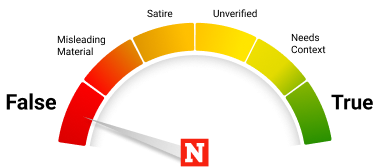A video posted on TikTok was widely shared on Wednesday, purporting to be a 911 call from a driver who said he was on the Francis Scott Key Bridge when it collapsed on Tuesday morning.
The post came after authorities announced that they had suspended searches for six workers who were on the Francis Scott Key Bridge in Baltimore at the time of the collapse.
The Coast Guard said that the six workers, who were fixing potholes on the bridge at the time of the collision with the Dali cargo ship, had been missing for too long to be found alive and they should be presumed dead.
Two other workers who had plunged into the river's waters were rescued on Tuesday. The TikTok shared on Wednesday included what was described as a "911 call" from a "survivor" of the incident.

The Claim
A TikTok posted by user @thedramatik, on March 27, 2023, viewed more than 3 million times, includes the heading "Baltimore Bridge survivor 911 call."
The TikTok shows a photo of the collapsed Francis Scott Key Bridge and a picture of a police officer. The accompanying audio depicts a phone call between a 911 dispatcher and an inbound caller as follows:
Dispatcher: 911, what's your emergency?
Caller: Hello? Oh my god, please help me.
Dispatcher: What, what's happening?
Caller: I'm underwater, I'm drowning, I'm so scared, my car is sinking.
Dispatcher: Okay, where are you?
Caller: I'm under the Batlimore Key Bridge. The bridge collapsed while I was driving.
Dispatcher: What, what do you mean the bridge collapsed?
Caller: I don't know it was like something hit it. Uh, my car is filling up fast with water. Help me. Now please help me.
Dispatcher: Listen to me very carefully, you need to try and open the door or break a window to get out. Can you do that?
Caller: The door, it won't budge. It's jammed or something. I'm gonna try the window. I broke the window. Water is rushing in faster now.
Dispatcher: Excellent keep talking to me. Tell me when you're out of the car.
Caller: Okay I swam out. I'm holding on to a piece of the bridge. Oh my god. The bridge is destroyed, he's gone.
Dispatcher: Oh, my god you're right. I see it on the news. Okay, hold on tight, I send the signal. The help is on the way.
Caller: Okay thank you so much.
The same TikTok was shared by users jacob.haider, who got more than 2 million views, karminreyes_, with more than 490,000 views, and _wsd.f, who received more than 71,000 views.
The Facts
This call is fake. The changes in tone of voice, accent, and irregular speech patterns throughout strongly indicate that the content has been artificially created, aside from the unusual premise of the call.
Newsweek sent the TikTok to A.I. experts for their thoughts.
Professor Manjeet Rege, Director of the Center for Applied Artificial Intelligence at the University of St. Thomas, told Newsweek there are several signs to indicate whether a 911 call is fake.
"One sign is unnatural speech patterns—AI-generated speech may lack the natural variations, disfluencies, like 'uh' or 'um', and emotional nuances present in real human speech, sounding overly monotonous or robotic."
The 911 call shared on TikTok contains almost none of these patterns.
"Another potential giveaway is abnormalities in the background noise," Professor Rege added
"Real 911 calls will have consistent background noises matching the reported scenario, while AI fakes may have inconsistent, unrealistic, or lack of appropriate background audio."
The pitch and sound of background noise changes throughout the TikTok, despite, ostensibly, the caller only being in one location.
Rege also noted "there is variation in one person's voice that shouldn't exist."
"That is, while supposedly hearing the same person in the call recording, it appears as if voices of similar sounding, but different people have been stitched together artificially," he added.
There were also contextual inconsistencies, Rege said, such as the dispatcher saying they could see the bridge collapsing on the news.
"It appears as if the dispatcher wasn't believing the caller until she verified it on the news," he said.
"Additionally, genuine callers in emergency situations exhibit authentic emotional responses that can be difficult for AI to replicate perfectly, resulting in an emotional disconnect."
Professor Ahmed Banafa, a published AI expert at San Jose State University, told Newsweek that after listening to the call multiple times, there were "no emotions of real fear or urgency or shock in the call" saying it sounded "scripted" and adding "anyone in that situation will be more emotional about his situation and not responding in this way,"
"Beside how can he swim and hold the phone at the same time describing what he is doing?" Banafa said.
"This is too calm for someone in that situation. I hope this is not real and it's just a fake call, and nothing happened to that person."
Along with the tone of the audio, there is also the practical unlikelihood that this call would have been released so soon after the bridge collapse.
While you can request 911 call recordings, the likelihood that such a request would be received and resolved in the space of a few hours on Tuesday is essentially nil.
Under Maryland Public Information Act (PIA) guidelines, a receipt of request can take up to 10 working days, in addition to the amount of time to produce the request, alongside any fee estimates.
The earliest upload of the "survivor call" on TikTok was around 8 p.m. ET. This means the request for the 911 audio would have been received and honored in less than 18 hours after the bridge collapsed.
Newsweek has contacted the Maryland Attorney General via email for further information about the PIA request process.
There's more room for doubt about the premise of the "survivor" call as well, with the "survivor" saying he was calling from inside a car that fell into the Patapsco River.
While cars did fall into the river, Maryland Transportation Secretary Paul J. Wiedefeld told CNN on Tuesday it's believed these vehicles belonged to the construction workers on the bridge, and that there were no known victims in those cars.
Newsweek has contacted Wiedefeld's office via email for further comment.
Additionally, the photo of the person shared along with the TikTok has nothing to do with the bridge collapse. It's a picture of Donald Sahota, a 52-year-old police officer who died in Vancouver, Washington, in 2022. Sahota was fatally shot while off-duty by another police officer who mistook him for a robbery suspect.
While the photo of Sahota alone is not enough to dismiss the authenticity of the audio, the use of his photo adds a further sense of bad faith and misrepresentation.
On the balance of evidence, combining the testimony of AI experts, the practical limitations behind acquiring the audio, early findings about the collapse, and the face value inauthenticity to the audio, this "survivor" call is therefore, almost without doubt, fake.
The Ruling

False.
This "survivor" call is fake. The caller's voice and background noise on the call change repeatedly throughout the recording, which experts told Newsweek, in combination with other tell-tale signs, is consistent with AI generation.
Furthermore, the practical likelihood of a 911 call being released from Maryland authorities so soon after the disaster is essentially nil. The photo attached to the TikTok video clip of the call is also of a police officer killed two years ago in Vancouver, Washington.
FACT CHECK BY Newsweek's Fact Check team.
Uncommon Knowledge
Newsweek is committed to challenging conventional wisdom and finding connections in the search for common ground.
Newsweek is committed to challenging conventional wisdom and finding connections in the search for common ground.
About the writer
To read how Newsweek uses AI as a newsroom tool, Click here.








